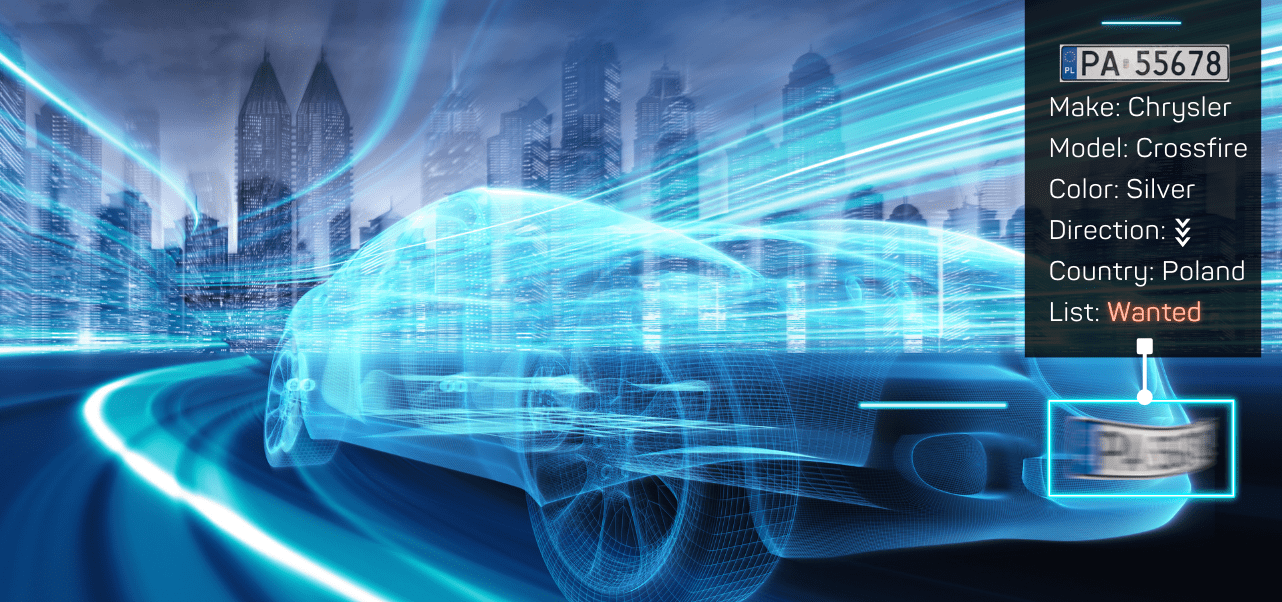License Plate Recognition System (LPR/ANPR)

Up to 99% recognition accuracy
100+ countries license plates support and counting
Up to 250 km/hour vehicle speed for license plate recognition
- 01 License plate capture and recognition within 8–30 milliseconds
- 02 Recognition of the make, model, and color of vehicle, as well as the country identifier
- 03 Determination of the route and direction of vehicle
- 04 Vehicle lists set up
- 05 Ability to work with different sources of video data
- 06 Ability to process statistical data and generate reports
- 07 Flexible access rights for different user groups
- 08 Search with ability to filter recognition data in the archive
- 09 Database support: MySQL, PostgreSQL, MS SQL, Oracle Database
- 10 Supports database import (CSV) and export (EXCEL/PDF/CSV/JSON)
- 11 Business logic constructor
- 12 Cross-platform and multilingual interface
What Is Automatic License Plate Recognition (ALPR/ANPR)
Automatic License Plate Recognition uses computer vision and AI license plate recognition models to identify plates in video or images, decode characters, and link them to useful context (time, location, make/model/color, direction, lane). In short, it turns raw camera feeds into actionable vehicle intelligence for parking management, safe city, retail loss prevention, logistics, and access control.
As per our expertise, a modern license plate recognition program typically includes:
- An edge or server-side inference engine (GPU/CPU/ASIC like NVIDIA Jetson, Intel OpenVINO).
- A license plate recognition camera (or any RTSP/ONVIF stream).
- A backend with storage, search, and license plate recognition online dashboard.
- APIs/SDKs to integrate with gates, VMS, parking payment, or ERP/CRM.
Why License Plate Recognition (ANPR) Matters Now
LPR has moved from “nice-to-have” to core infrastructure:
- Security & safety: instant watchlist alerts, stolen vehicle detection, campus safety.
- Parking automation: barrier-free entry/exit, license plate recognition payment, fewer queues.
- Operations & analytics: real-time occupancy, dwell time, fleet routing, parking operations license plate recognition KPIs.
After conducting experiments with it across different sites, our findings show that aligning the license plate recognition system with your data flows (access control, billing, reporting) makes or breaks ROI.
How an Automated License Plate Recognition System Works
01
Frame ingestion: time & geo metadata captured from the stream.
02
AI inference: detect plate, read characters, identify make/model/color/route.
03
Decisioning: compare against lists (VIP, blacklist, fleet, visitor).
04
Action: trigger real-time notifications, open gates, start billing, store and report.
Core Features of IncoreSoft’s License Plate Recognition Program
- Multi-source video input (IP cameras, VMS, archives).
- Advanced search with filters (plate, make, date, region, color).
- Real-time alerts and notifications.
Powerful analytics & statistical reports.
Flexible access rights for operators and administrators. - Integration-ready APIs for ERP, VMS, and parking systems.
- Cross-platform, multilingual interface for global deployments.
Tech Stack & Integrations That Keep You Future-Proof
- Cameras: ONVIF/RTSP streams; license plate recognition camera system models from Axis, Hikvision, Dahua; thermal/IR for night.
- Inference: YOLO/Transformers, OCR, temporal tracking; CUDA, TensorRT, OpenVINO.
- Data Layer: MySQL, PostgreSQL, MS SQL, Oracle; CSV/Excel/PDF/JSON import/export.
- APIs: REST/GraphQL, webhooks; VMS (Milestone, Genetec), parking management systems, payment gateways.
- RBAC & Multilingual UI: granular roles; English + EU languages for LPR, ANPR for EU. As indicated by our tests, edge inference + server aggregation hits the sweet spot for latency and cost.
Accuracy, Speed & Tough Conditions
- Illumination & weather: HDR sensors, IR illuminators, anti-glare optics.
- Motion blur: high shutter speed; up to 250 km/h lanes with proper optics.
- Plate variety: region-specific templates; 100+ countries supported.
- Integration: seamless connectivity with VMS, ERP, and third-party systems via APIs/SDKs.
- Scalability: adaptable architecture supporting small deployments to nationwide networks.
Privacy, Security & GDPR
- Data minimization & retention policies per site.
- Encryption in transit/at rest, signed logs, tamper alerts.
- Role-based access (RBAC) and audit trails.
- Data subject rights workflows (export, purge).
Industries We Serve
Empower law enforcement with real-time alerts, stolen vehicle detection, and traffic route analysis.
Monitor bus lanes, enforce priority rules, and optimize depot operations.
Simplify resident/visitor access with automatic recognition and audit logs.
FAQs
ALPR/ANPR reads plates and context (time, location, vehicle attributes) and triggers workflows, whereas motion detection just spots movement.
Look for high-shutter, IR-assisted, WDR cameras (Axis, Hikvision, Dahua), mounted at proper angles with lane-appropriate focal lengths.
Yes—streams can go to cloud inference, but As indicated by our tests, edge inference often wins for latency and bandwidth, with the cloud for archiving and analytics.
With solid optics and tuning, up to 99% on clean plates is realistic. Expect lower on dirty/damaged plates—but post-processing rules help.
The license plate recognition parking solution pairs a plate with a session; payment posts automatically on exit via wallet, card-on-file, or QR.
Absolutely. Most platforms expose REST/GraphQL APIs and webhooks for parking management, VMS, POS, and billing integrations.